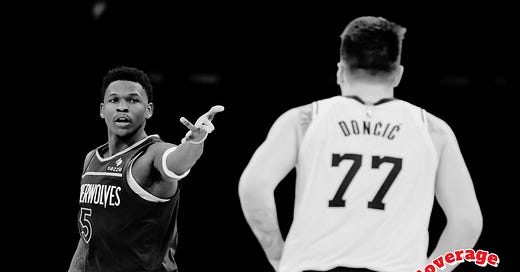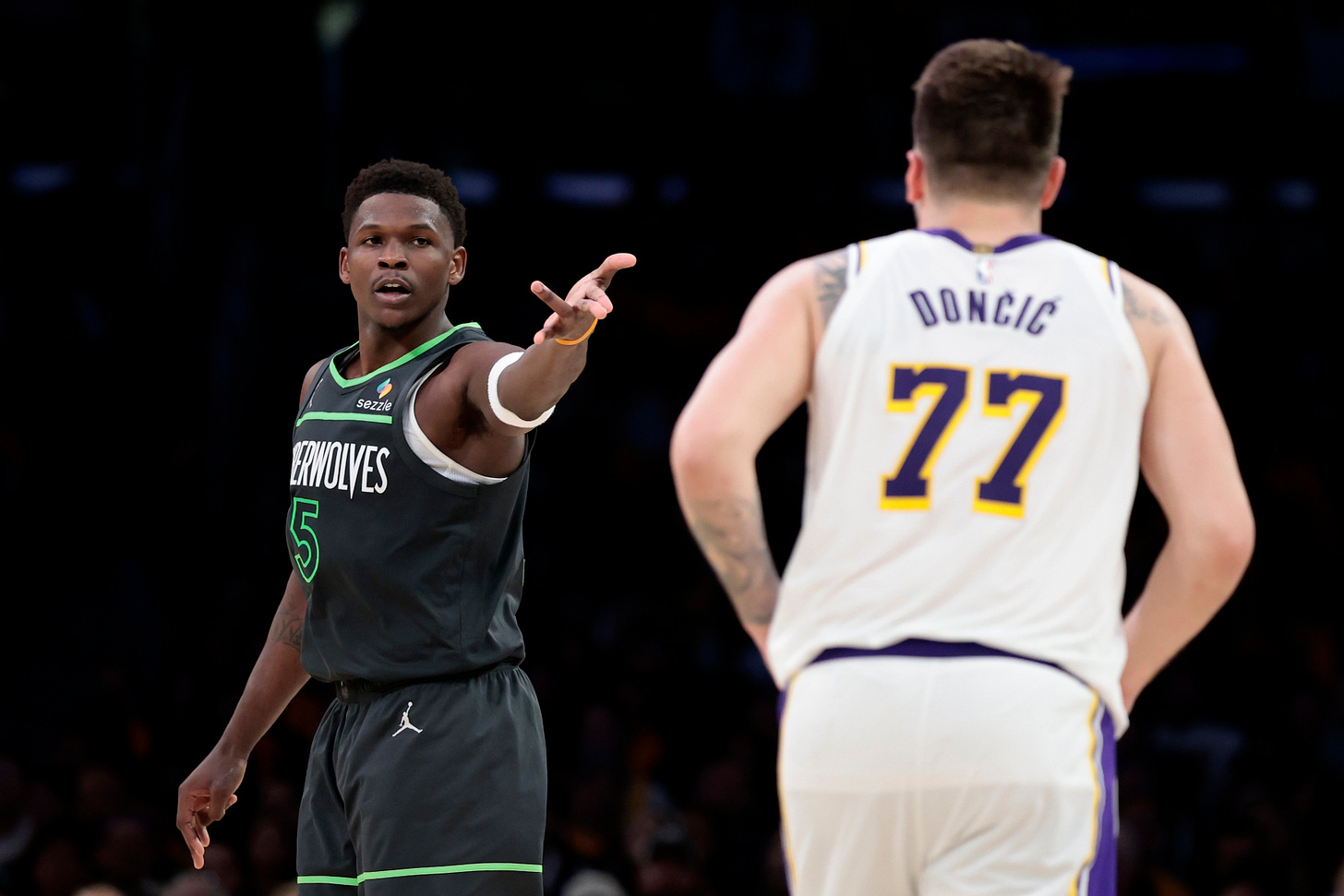Lakers-Wolves Game 1 Observations
Wolves played with more force and focus, and hit the Lakers first—and hard
And so it begins.
Not the start Lakers fans hoped for. Not the one my numerous Luka followers here envisioned either. But Game 1 of the playoffs is always about who throws the first punch. And what turns that punch into a series is how the team that got hit responds.
And boy, what a counter the Wolves threw after Dončić’s opening jab. His 16-point first-quarter salvo was impressive, but Minnesota answered with a 38–20 second quarter, flipping the game and building a lead that ballooned to as much as 27 points.
After the game, Lakers head coach J.J. Redick admitted his team was mentally ready, but physically not there, saying it took them nearly two quarters to respond and bring the level of force required to win a playoff basketball game.
Playing with more force than your opponent is probably the most important ingredient in the recipe for winning a basketball game. But playoff games are more complex than that—there are tactical layers, adjustments, and mental battles at play.
For all the new subscribers here: I’ll be breaking down every Lakers playoff game through these Game Observations. Game 1 observations for each series will remain free and available to all readers. For the rest of the games—and deeper series analysis—some parts of the content will be reserved for paid subscribers.
If you have the means, consider supporting the work. It’s your support that keeps this going.
Today’s notes:
Luka’s early scoring: an accidental tactical favor to the Wolves? (🎞️VIDEO)
Wolves’ hot shooting not just luck (🎞️VIDEO)
Lakers lose round one of small-ball vs bigger Wolves
More structure, more half-court pace, more pressure to dictate terms
A couple of positives heading into Game 2
1-Luka’s early scoring: an accidental tactical favor to the Wolves? 🎞️VIDEO)
Dončić came ready to play from the opening tip. You could tell he was eager to see what scheme Chris Finch had cooked up to defend his pick-and-rolls with Gobert involved. As usual, Finch threw out a mix—some drop, some drop with a late switch, all within the first few minutes. And Luka went right at it, taking Gobert for a dance on the very first possession, drawing a foul on his French ‘friend’. He scored on another, then kept torching Gobert and the rest of the Wolves early, almost at will.
Dončić scored 16 points in the first quarter, outscoring the Wolves 14 to 12 by himself through the first eight minutes.
Post-game, both Dončić and Redick were asked whether the Slovenian superstar’s dominance might have thrown his teammates off rhythm. But I don’t think that was the issue. They’ve seen Dončić drop the hammer before—setting the tone, applying pressure, and forcing early adjustments.
I think the problem in this game was that the forced adjustments actually worked in the Wolves’ favor.
Luka played Gobert off the floor—Minnesota’s defensive anchor picked up his second foul against Dončić later in the first quarter, and his third one, again vs Dončić, later in the second. Less Gobert meant less need for Mike Conley (who I highlighted as one of the key targets in my series deep-dive), the two veterans played just 24 and 22 minutes, respectively. It meant more Naz Reid and more Jaden McDaniels. So a lot more shooting, and faster, more switchable lineups. It also meant a lot less Jaxson Hayes, who is less effective against switching, which meant less rim protection as well. All of that turned into a real problem for the Lakers (see my next points).
2-Wolves’ hot shooting not just luck
Yes, the Wolves shot the lights out. They went 21 of 42 from three, 50 percent, and outperformed their expected shot quality by 22 points. For comparison, the Lakers were 15 of 41, 37 percent, and just 1 point above expected, mostly thanks to Dončić hitting 5 of 10 from deep.
However, it wasn’t all just luck. The more physical Wolves decisively won the rebounding battle against the Lakers (see the Four Factors and the gap in offensive rebounding percentage). Several of their wide-open threes came off second-chance opportunities created by those rebounds.
Rebounding wasn’t the only problem. Getting killed in transition—a persistent issue for the Lakers—was an even bigger concern. And it wasn’t something you'd necessarily expect against a slow-paced Wolves team. But without Gobert, the Wolves pushed the pace off every turnover and Lakers miss, building a 25 to 6 edge in fast break points. Five of the Wolves’ 21 made threes came from advantageous situations in transition.
3-Lakers lose round one of small-ball vs bigger Wolves
The other reason the Lakers gave up so many threes—especially the problematic, out-of-rotation looks from the corners, where the Wolves went 9 of 12—was that they were punching above their weight for most of the night.
Shrinking the floor and showing help against Anthony Edwards was expected, although at times it felt excessive and poorly coordinated.
But Naz Reid playing extended minutes, and probably some of the best of his career, meant two things. More shooting on the floor, which led to longer and tougher rotations. And, along with McDaniels, another big who could punish mismatches in the post.
Austin Reaves was the main and consistent target on the block, and the Wolves created advantages more often and more reliably throughout the game. Reid and Jaden McDaniels put on (a hard-to-repeat ?) masterclass in advantage basketball, combining for 48 points on 19-of-25 shooting from the floor.
4-More structure, more half-court pace, more pressure to dictate terms
Minnesota’s switching defense forced them into a familiar trap—stagnant, one-on-one isolation battles we've seen from them before.
The Lakers needed more pace, more structure, and more movement in the half-court—especially on a night when only Dončić was scoring efficiently in isolation. Dončić finished with 37 points on 54 percent shooting, while James, Reaves, and the rest of the core rotation combined to shoot just 19 of 53, or 36 percent.
We’ve seen the Lakers respond to stagnant nights like this before by leaning into more structure—what Redick has called “exhausting all options” from their sets. That often means running Dončić–James–Reaves three-man actions with counters against help until they’ve truly run out of options, instead of settling for one-on-one bravado too early.
James and Reaves will also need to be better and prove that the Lakers’ edge in ball-handling and self-creation can be the decisive factor that flips this series. The Lakers lost a brief 3:40 stretch at the start of the second quarter by 9 points, with both Dončić and Edwards on the bench. That’s a stretch James and Reaves should have taken advantage of, but one they’ve struggled with in the past.
For the Lakers to win the small vs big battle against the Wolves, Redick, James, Dončić, and Reaves need to create a better environment for the star trio to attack Randle, Reid, and others—and they need to execute it better. In James’ case, that probably means smarter mismatch selection, going at smaller defenders rather than bigs. For Reaves, it’s the other way around.
Simply put, the Lakers must be much better in half-court offense to have a real chance in this series and to limit the much more ahtletic Wolves’ transition opportunities.
5-A couple of positives heading into Game 2
Luka continues to look spry and confident: Heading into the series, I wrote about Luka’s playoffs X-Factor—his ability to create angles, get into the paint, and finish once he gets there. That was a real issue earlier in his Lakers tenure, but it’s a trend that’s shifted significantly over the last two weeks of the regular season. Dončić picked up right where he left off, scoring from the outside and inside—whether it was driving against Gobert, McDaniels, or others within the arc. He finished 7 of 12 on two-point field goals. The Lakers need Dončić to be the best player in this series—and last night, he showed that he can be that.
(Too) late level of physicality: In the intro, I mentioned the Lakers’ lack of force and physicality early in the game. Rui Hachimura struggled the most to adjust to the playoff speed and intensity. The Lakers finally flipped the switch late in the third quarter, playing much more aggressive defense. Jarred Vanderbilt made an impact with his defensive playmaking, and the lineup of Luka, LeBron, Vincent, Finney-Smith, and Vanderbilt brought the right mix of physical activity and pressure.
Austin Reaves’ second half: Reaves looked lost in the first half—he went 1 of 6 from the field, scored just two points, and was a frequent target for the Wolves, who attacked him with Edwards or bigger players on the block. Reaves was much better in the second half, scoring 14 points and finding a better rhythm. He’ll need to be more patient and composed in Game 2. Reaves is the Lakers’ best downhill attacker, so they’ll need to create cleaner opportunities for him to attack slower defenders like Gobert, McDaniels, and Reid.






